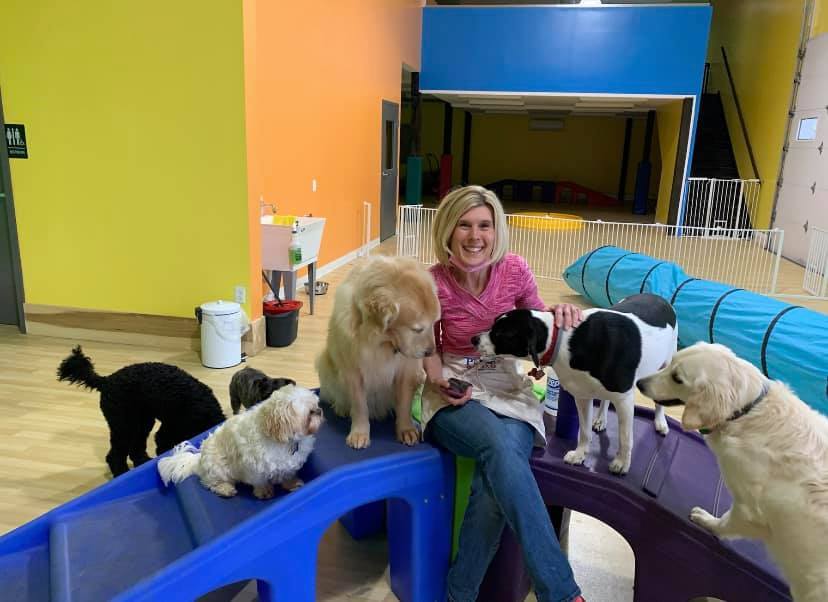So, you’ve decided to start a doggy daycare. Maybe you’re a huge “dog person,” or maybe you’ve noticed a need in your community and are ready to fill that space with what will hopefully be a profitable venture.
Regardless of what’s landed you here, there are quite a few steps between choosing to open a dog daycare business and actually welcoming your first furry guest. This guide will provide an overview of everything you need to get started with your dog daycare business plan. After reading it, you’ll hopefully have a good foundation to begin brainstorming for your new venture.
While this guide covers the basics, there’s still a decent amount of information to dive into. Feel free to navigate to a specific section of this guide if you know what you’re looking for. If not, continue reading to get started.
How to Start a Doggy Daycare: FAQs
 How do you start a dog daycare business?
How do you start a dog daycare business?
Before you begin accepting reservations and purchasing every dog toy you can get your hands on, there are a ton of business considerations to work through for your dog daycare.
Creating a dog business plan is the first place to start. In your business plan, you’ll define:
- An objective and mission for your business.
- Your cohesive brand and marketing strategy.
- Your competition and how you’ll stand out from the crowd.
- The facilities you’re going to utilize.
- How you’ll remain profitable, addressing costs and revenue.
You’ll need to decide where your business will be located, who you’ll be working with, which services you’ll offer, and which tools and software you need to offer those services. You’ll need to decide all of this— as well as how you’ll fund the venture overall— before actually putting any of these plans into action.
Do I need a license to start my dog daycare?
You will likely need specific licensing to start your dog daycare facility.
For starters, you’ll need to obtain the proper business licenses required of any start-up. While some businesses will need federal licenses (ex: restaurants selling alcohol), your doggy daycare licenses will probably be handled on the state and local levels.
Each state and locality handles this licensing differently, from which types of licenses are required to the requirements needed to fulfill such licenses. For example, some states require different permits and licenses for dog daycares versus dog kennels, with the key difference being dog kennels also house animals overnight. Other states might l have stricter zoning and size requirements for businesses looking after animals.
Because of that, your best bet is to contact your state and local licensing bodies for definite answers. While it might be frustrating digging into your region’s laws, remember these requirements are aimed at keeping the animals in your care as safe and healthy as possible.
How much can you earn owning a dog daycare?
When it comes to the earning potential of a dog daycare, the answer will vary depending on your specific circumstances.
There are a ton of factors that go into how much you can earn owning a dog daycare, including:
- The services you provide (daily dog care, grooming services, overnight care, etc.).
- How you price services.
- How money-savvy you are once operational.
- The need for such a business in your community.
Every aspect is unique to your personal situation, including your initial investment, the pricing of licenses and permits in your area, and even the cost of daily operations.
As you continue reading, you’re going to explore various profit equations. Use those equations to predict the daily, weekly, monthly, and yearly profitability of your dog daycare under certain estimated circumstances.
Profitability of a Dog Daycare Business: Key Considerations
 While we’d love to say your dog daycare business can sustain itself on a love for dogs alone, that’s just not the case. To open your dream business and keep it open, you have to stay profitable throughout the process.
While we’d love to say your dog daycare business can sustain itself on a love for dogs alone, that’s just not the case. To open your dream business and keep it open, you have to stay profitable throughout the process.
As you’ll see, this requires your revenue to outweigh your costs. This means the payments you’re receiving from customers have to (collectively) be more than the cost of providing those services. The costs include rent, staff wages, utilities, and dog-care specifics such as pet-care management software, animal-friendly cleaning products, dog treats and food, and any other costs of operation.
There are a ton of variables to juggle to ensure your dog daycare is profitable. Use the following equations and considerations to help make sense of it all.
The Profit Equation
No surprise here— but keeping the doors open to your doggy daycare requires keeping the business profitable overall. This requires ensuring your incoming revenue is higher than your outgoing costs, which is where the profit equation comes into play.

First, let’s look at a few key terms in this equation:
- Revenue: This refers to the price you’re charging for services multiplied by the number of services you deliver by that price. So, for example, if you charge $25 per day for daycare services, and care for 50 dogs on a given day, your revenue is $1,250 for that day.
- Variable Costs: This refers to the business operation costs that change day-to-day, varying with how busy you are at any given moment. This includes hourly staff wages, providing food to animals (if you do so for free), or cleaning services linked to the number of animals in your care at any moment.
- Fixed Costs: This refers to your operational costs that have little variation. For example, monthly rent and insurance payments are a fixed cost.
- X: The “X” refers to the unknown variable that affects how your revenue or variable costs are changed (multiplied) for the number of dogs in your care. So, how much revenue you’re making with X number of dogs and how high your variable costs are with X number of dogs.
Essentially, to successfully operate a doggy daycare, your profit has to be positive. This is a large overview calculation, and now we’ll break it down into more specific considerations.
Gross Profit
Gross profit refers to the profit your dog daycare business makes after you deduct the costs associated with providing your services. Specifically, this looks at the money you make with one particular transaction compared to the cost of providing that service.

Let’s define a few key terms:
- Revenue: In this equation, revenue refers to the profit brought in per dog cared for. For example, $25 for one dog, one day.
- Cost of Goods/Services Sold: This variable refers to the cost of providing dog daycare services for one dog. This includes hourly wages represented in that dog’s stay, the cost of receiving and processing payments, and any other costs related to managing one sale of your services.
This equation adds specificity to the original profit equation by telling you the profit your daycare makes from each and every dog in your care. Essentially, the equation gives you a variable profit multiplier— a number to multiply by the number of dogs in your care at any given time to calculate that day’s profit.
Net Operating Profit
Net operating profit expands upon the gross profit equation, adding fixed costs to your considerations. Rather than looking at one transaction (ex: one dog cared for on one day of operations), this equation looks at your total revenue and operating costs over a time period.

The goal of this equation is to see how much of your revenue will translate to profit. Because it is an equation looking at finances over time, it’s essential that you keep time units consistent across the board.
- Net Profit: This number is a representation of your gross profit (refer to the previous section) over time. Essentially, the net profit equation looks like this: Net Profit = (Gross Profit Per Dog x Number of Dogs) x Number of Days in Time Period
- Total Fixed Expenses: This represents your fixed costs across a time period. For example, $10,000 per month.
This is similar to the general profit equation from the first section. The key difference is that net operating profit combines the Revenue and Variable Costs sections into one overall Net Profit variable.
Pricing as Branding
While it’s essential that each of these equations results in a positive profit for your dog daycare to stay afloat, there are other important considerations to make when setting your business’s prices.
How you choose to price your services sends a strong message to your customers, and setting these limits too low (or high!) can give a negative first impression.
This pricing tells potential customers where your business lies in the market of doggy daycare services. If your pricing is too low, customers may fear you’re providing sub-par services to provide discount pricing. On the other hand, if your pricing is particularly high, you’ll have to make a strong case for the investment. If your pricing is too complicated, you’re likely to deter customers as well.
Many dog daycare businesses have successfully provided higher-quality service (for example, a lower dog-to-staff ratio) paired with a slightly higher price point. In that case, you must support your pricing with a strong branding strategy, great first impressions, and a positive customer experience reputation.
If all of these equations and considerations seem a bit overwhelming, don’t fret— Gingr has put a lot of thought into dog daycare profitability. Check out our Doggy Daycare Profitability Model Spreadsheet to begin your profit analysis.
Elements of a Winning Dog Daycare Business Plan
A serious love for animals and a knowledge of profit equations aren’t enough to build and grow your future dog daycare business— there are a few other elements that are necessary for any successful dog kennel business plan.
With that, let’s explore the essential elements of a successful dog daycare business plan:
Define Your Brand
 Dogs are often cherished as family members themselves, so for their human counterparts to feel comfortable leaving them in your care is a huge decision. Branding your dog daycare or kennel effectively is how you show these owners that you’re the right fit for their four-legged friend.
Dogs are often cherished as family members themselves, so for their human counterparts to feel comfortable leaving them in your care is a huge decision. Branding your dog daycare or kennel effectively is how you show these owners that you’re the right fit for their four-legged friend.
There are two steps to this— defining your brand and communicating that brand.
When defining your brand, consider what makes your dog daycare stand out from the others in your community. What makes you and your staff so passionate about caring for pets? What makes your approach to pet-care superior to others in your field?
For example, maybe your daycare specializes in providing care to senior dogs, centering your branding around a laid-back, relaxed atmosphere. Or, maybe your key selling point is the expertise of your staff, who have advanced experience in puppy etiquette and training. Find your key selling point and brand accordingly.
From there, this brand must be consistent across all communications you have with potential and current customers. Your facility, website, social network profiles, and any advertisements and direct communications you send out should convey this consistent branding.
Know Your Competition
This is where you get into the nitty-gritty of what makes your doggy daycare better than others in your community. We know that competition is increasing in the dog daycare realm, both in more traditional daycare settings and newer home pet-care camera technology.
Research other local facilities and popular options to ensure you’re offering features that make you stand out from the crowd. Some ways to truly make your mark as the premier dog daycare facility in your community are:
- Set competitive pricing compared to others in your area providing similar services. Don’t make the mistake of setting your pricing significantly higher or lower than your competition, as you’ll stand out for all of the wrong reasons.
- Offer a peek into your operations. Streaming video from inside your facility (ex: in a dog play yard) and sending home a doggy report card reassure owners that your daycare is a safe, fun space for their pets.
- Leverage convenient, customer-oriented software tools. Manage your operations using software made for dog daycare businesses, with convenient online booking and payment, one-click check-in, and easily managed recurring services.
If branding is the key to making customers feel emotionally comfortable sending their dogs to your daycare, standing out from your competition is the key to making them logically comfortable.
Choose the Right Facilities
To successfully open a dog daycare or kennel, you also have to invest in superb facilities. Choosing your space is often a balance of two desires:
- Having enough space (and maybe even built-out facilities) to provide the best care possible to your customers.
- Being within your budget to not diminish the profitability of your business overall.
Because choosing a facility is an investment, you’ll want to really do your research before settling into one location.
Remember that each state and locality will have different statutes and zoning laws playing into your facilities as well. From where in the community you’re allowed to set up shop, to how large your facilities need to be— there’s a decent chance your state and local government have an opinion on what’s acceptable as well.
Leverage Effective Software
 You’ll soon realize that analog methods of managing your business will be ineffective as it expands and grows. Your best bet is to invest in the right dog daycare software from the start, allowing it to scale with the business as it grows.
You’ll soon realize that analog methods of managing your business will be ineffective as it expands and grows. Your best bet is to invest in the right dog daycare software from the start, allowing it to scale with the business as it grows.
However, if you’re new to the dog daycare business (or simply looking to improve operations), you may not be familiar with this type of software. Start by evaluating what your customers and staffers are looking for in a software solution. Popular features to look for in a pet-care software solution are:
- Client and pet management features. This includes unlimited client profiles with photos, paperless waivers and other signed agreements, hidden internal staff notes for specific clients, and easy access to vaccination records, to name a few.
- Online booking and customer portal. This should be mobile-friendly, allow for digital signing of waivers and uploading of vet records, have the ability to collect deposits online, and even let customers view photos and videos of their pets. Plus, you should be able to customize the services, features, and forms available through online booking.
- Reservation management features. Look for easy customization of reservation types and viewing of availability, both for your staff and customers. Further, look for simple check-in/check-out procedures that still ensure you have all of the information needed to provide a safe stay.
- Communications features. Your customers will appreciate automatic communications for reservation confirmations and reminders, vaccination reminders, and report cards. Your staff will appreciate it when they don’t have to waste time manually sending these communications.
- Retail features. The ability to use your software as a point-of-sale system and offer add-on services and retail products will increase the profitability of your business.
- Marketing features. Top software can send SMS and email marketing communications quickly and easily. Further, you should be able to filter your customers and customize communications easily.
- Staff management features. Features to manage your staff, such as personalized to-do lists, commission tracking, a time-clock with associated reports, and even specialist scheduling (groomer, trainer) will drastically improve your internal processes.
Choosing the right software from the start will set your business up for success going forward. You’ll cut down on staff costs, lessen the risk of error, and stand out from the crowd with customer-facing features.
At Gingr, we’ve been working to create the best pet-care software platform possible for business owners like yourself.
See how Gingr can revolutionize your pet-care business. Book a demo today!
Subscribe to the Gingr Blog







